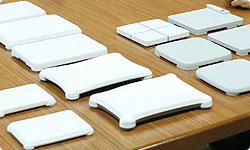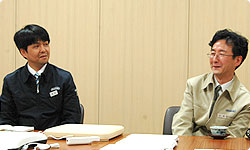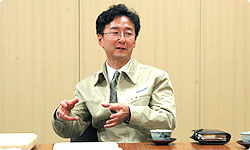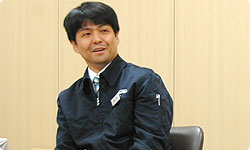4. A Controller for the Feet
Just out of curiosity, when you began work on this product, did you ever expect it to be such an important product for the company?
Not when it was still just a square, no!
(laughter)
The prototype we made didn’t seem to be anything more than a device similar to bathroom scales, and I didn’t think there would be much room for improvement. But as we continued working on it, I think it became easier to add more ideas to it. I’ve brought the miniature prototypes that we came up with on the way to creating the final design, so please take a look at them.

It’s impressive looking at them all lined up like this! (laughs) I didn’t observe the whole development process, so this is pretty striking.
As the shape of the product changed, we had to keep changing the interior architecture as well. Each time, we had to also make sure that the machinery was sturdy enough, and that took up a lot of time. But when I compare these prototypes with the final product, I can’t help but think that this is what it was always supposed to look like.
How on earth did you manage to develop something this strange? (laughs)
Good question! (laughs) I mean, this product has been officially certified as proper bathroom scales, and it’ll even feature the sticker to prove it12. Having said that, I feel a real sense of accomplishment from having helped Nintendo develop something as novel as the Wii Balance Board – officially-approved bathroom scales made by a video game company. 12 The Japanese version will carry this sticker but the Wii Balance Board sold in Europe and South Africa won't feature it, as there isn't the same certification scheme requirement. The certification process discussed in the following conversation does not apply for Europe or South Africa.
Nagareda-san just mentioned the certification process, but it really was quite difficult overcoming that obstacle. I can’t really talk about it in detail because it’s very technical…
Sawano-san and his team took care of all these negotiations, and it seems to have been a really draining process. At one meeting, someone suggested that we display only the BMI13 and not the weight, in spite of us having received this official certification, because of our production arrangements and forecasts. This really wound up Miyamoto-san, who slammed the table when he heard this comment. 13 Abbreviation for Body Mass Index - an international index which describes the physique of the body.

He’s pretty scary when he disagrees with something about a project, isn’t he? (laughs)
Miyamoto-san banged the table and said, “That’s wrong!” He told this person that from the consumer’s point of view, clarity was important. That people don’t say, “You need to lose 2 BMI points to reach your ideal weight”, they say, “You need to lose 3kg to reach your ideal weight”. We wanted people from age 5 to 95 to enjoy using Wii and he pointed out that most of those people wouldn’t know what BMI is. He demanded to know how this person could be so backward-looking when so many employees were working so hard to negotiate with official organisations to allow kilograms to be displayed in the game for the benefit of the consumers. The whole time, he was banging his hands on the table. I was there at the time, and I agreed with him entirely.
To sum it up, considering things from the consumers’ point of view was a very important factor in creating the Wii Balance Board. I think it’s clear that the Wii Balance Board went through an enormous amount of trial and error before it was ready to be shipped off to the world. Thank you, both of you, for putting so much time and effort into this project. Lastly, could you say a few words for our customers, from the point of view of someone who develops hardware?
I hope that the Wii Balance Board is used by as many customers as possible, and hope that it contributes in some way to helping improve their general health. I would really be delighted to hear somebody say that their family was exercising regularly using Wii Fit. Also, I hope that a good variety of software for the Wii Balance Board will be produced and distributed as WiiWare, just as Iwata-san mentioned in the last instalment of Iwata Asks. Sometime during development, I started looking at the Wii Balance Board as more than just an accessory that could weigh players and more like a controller used with the feet. I think there’s a lot of fun stuff you can do by applying human balance to gaming, and I hope lots of different people step up to the challenge.

As a developer, I couldn’t ask for more than having various third-party companies to use this technology to create products that can be enjoyed by numerous customers, just like Sawano-san said. I think there’s a lot of potential for creative methods of game control, especially when combined with the Wii Remote.

Hardware people always seem to make comments geared towards software developers! (laughs) So your goal is for as many people as possible to use this technology in their own way, just like with d-pads and buttons on controllers. I think I’ll tie this in with my next interview by talking to the software developers behind Wii Fit. I’m sure to get a new perspective on this project, so I will be looking forward to that.